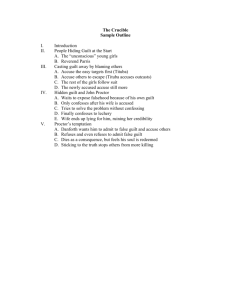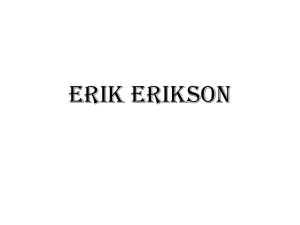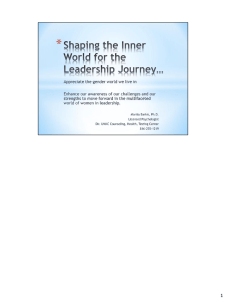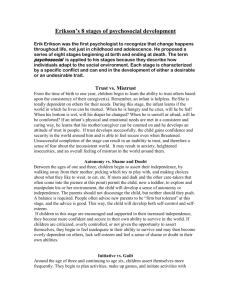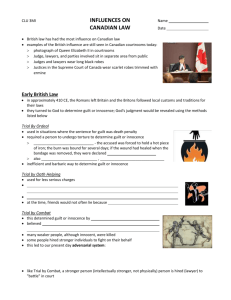EXAMINING THE ROLE OF GUILT IN BEHAVIOUR MODIFICATION POLICIES Fay Niker
advertisement
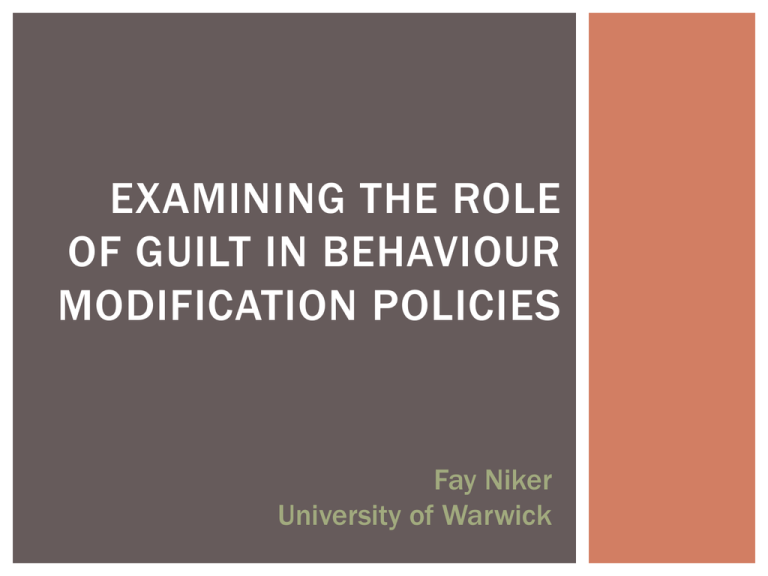
EXAMINING THE ROLE OF GUILT IN BEHAVIOUR MODIFICATION POLICIES Fay Niker University of Warwick RECENT PAPERS ¡ Theotokis and Manganari (2015): § Starting point: our understanding of the “underlying mechanism” of behaviour modification techniques (such as default rules) remains “obscure”. § Hypothesis: “anticipated guilt” is main underlying mechanism. § Findings: opt-out default > opt-in default at engaging people’s compliance because it increases anticipated guilt. ¡ Hedlin and Sunstein (2015): § Starting point: testing how active choosing policies fare in terms of effectiveness, versus opt-out defaults. § Findings: (i) active choosing led to higher enrolment; (ii) it caused participants to feel more guilty about not enrolling; and (iii) the level of guilt was positively related to probability of enrolling. SOME CONFUSION ¡ At first sight: findings might be taken as showing that people are motivated by guilt-avoidance. ¡ But: both sets of authors make statements to the effect that the story is more complicated than this. ¡ And: both of sets of authors make statements that indicate that they might have different conceptions of the role of guilt. ¡ Modest aim: to clarify the different possible ‘guilt-involving’ mechanisms that might have generated these findings. THREE MECHANISMS ¡ Main distinction: is guilt-inducement proposed as policy tool? ¡ Yes: (1) Guilt-avoidance mechanism; (2) Educative mechanism. ¡ No: (3) ‘Ecological persuasion’ mechanism. ¡ Interestingly, (3) does not use guilt at all; shows that the reports of guilt in the studies might be understood as evidence that mechanism/ policy -design is effective. ¡ Distinctions: potentially important for normative reasons. DEFINITION OF GUILT ¡ “By guilt we refer to an individual’s unpleasant emotional state associated with possible objections to his or her actions, inaction, circumstances, or intentions. Guilt is an aroused form of emotional distress that is distinct from fear and anger and based on the possibility that one may be in the wrong or that others may have such a perception. Thus we focus on feelings of guilt rather than guilt in a legal, technical, ontological, or theological sense.” (Baumeister et al, 1994: 245) ¡ Covers feelings of anticipated guilt. ¡ Distinguished from shame on the basis of specificity (Lewis, 1971; Tangney, 1991, 1998; Tracy and Robin, 2004). (1) GUILT-AVOIDANCE (SIMPLE) ¡ Guilt-avoidance motivation proposed as policy lever (#1). ¡ P à G à B, where: § P = behaviour modification policy; § G = feeling of guilt; § B = desired behavioural outcome. ¡ P “induces”, “activates”, or “triggers” G, and the person’s desire to get rid of unpleasant feelings motivates them to conform to performing B. ¡ ‘Guilt pill’: induces feeling of guilt about performing not-B without affecting or changing agent’s understanding of the reasons that apply to her. (1) GUILT-AVOIDANCE ¡ Theotokis and Manganari: variant of this mechanism? ¡ “consumers are stimulated to act against the cause of the guilt, in order to alleviate the harm caused and consequently the feeling of guilt” (2015: 425). ¡ ‘Guilt-avoidance as motivator’ view: § (i) Agents are motivated to satisfy their preferences; § (ii) The agent prefers to avoid G; § (iii) Under P, if the agent performed not-B, then G; § (iv) Thus, under P, the agent is motivated to perform B. (2) EDUCATIVE PROPERTIES ¡ Educative properties of guilt proposed as policy lever (#2). ¡ Aim: B is performed out of an appreciation of the reasons in favour of performing B (R), not out of desire to avoid G. ¡ Theotokis and Manganari: “The feeling of guilt will […] urge consumers to consider their ethical responsibilities” (p. 426). ¡ Hedlin and Sunstein: feelings of guilt “trigger moral values and social norms”. (2) EDUCATIVE PROPERTIES ¡ ‘Guilt as highlighting reasons’ view: § (i) Agents are motivated to conform with the reasons that they believe apply to them; § (ii) Under P, G; § (iii) G highlights (or triggers consideration of) R; § (iv) Under P, if the agent performed not-B, then she would not be conforming to R; § (v) Therefore, under P, the agent is motivated to B. ¡ Trades on theory of action in which behaviour is explained by both beliefs about reasons and emotions. § Emotions might play a role in “reason-tracking” (Jones, 2003). ¡ Modest normative statement: We have reason to prefer the educative, over the guilt-avoidance, guilt-inducing policy lever. GUILT: PLAYING ANY CAUSAL ROLE? ¡ Hedlin and Sunstein’s results are compatible with the interpretation that guilt (i) is not used/ proposed as policy lever; and (ii) plays no causal role in behaviour modification. ¡ H&S interpret result that active choosing > default because: “When people are required to choose, that mere requirement might trigger otherwise dormant or ineffective moral values and social norms”. ¡ When asked (i.e., forced choosing policy design), people tend to respond with “what they believe morality requires”. ¡ The thought of diverging from this is what triggers G. (3) GUILT AS BY-PRODUCT ¡ P à R à B G ¡ G = by -product of recognizing reasons that apply to them. ¡ Thus G plays no causal role in changing the agent’s behaviour. ¡ Aim: to make reasons that people might have to B more salient within the choice environment. ¡ Reported G = evidence that policy is effective at doing this; hence, has probative importance. (3) GUILT AS BY-PRODUCT (+) ¡ Can Theotokis and Manganari’s results be interpreted in this way? – Yes and No: (i) G is not used/ proposed as policy lever; but (ii) does play some causal role in behaviour modification. ¡ T&M state at one point: “when consumers anticipate that their actions will harm the environment by participating in a nongreen service, anticipatory guilt is likely to occur, which in turn will urge them to protect (or not to harm) the environment in order to eliminate the feeling of guilt” (p. 426; italics added). ¡ P à R à B G ¡ G = by -product of reason-recognition and motivation to B. (3) = ‘ECOLOGICAL PERSUASION’ ¡ ‘Ecological’: reshaping environments in order to achieve our individual and social goals, in light of evidence about how (much) contextual details impact on behaviour (Levy, 2012). ¡ Rational persuasion involves the activity of offering reasons. ¡ // Ecological persuasion involves activity of offering reasons by designing policies that make the reasons that might apply to people more salient within their choice environment. ROUND-UP ¡ (i) There are different ways of understanding the role of guilt in behaviour modification policies. ¡ (ii) Hedlin and Sunstein’s results are interpreted best in accordance with the third mechanism. ¡ Policy ‘take-away’: If this is the right interpretation of their results, then active choosing policy designs should be preferred to opt-out default rules because the results show that they are more effective at promoting reasonsresponsiveness.


